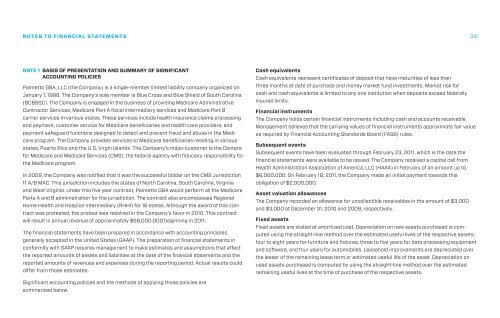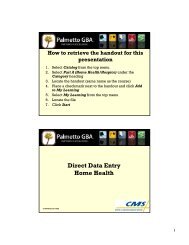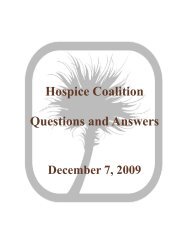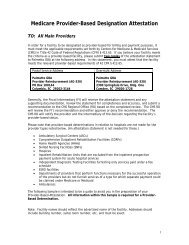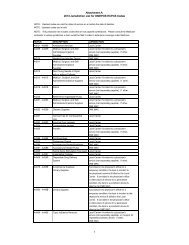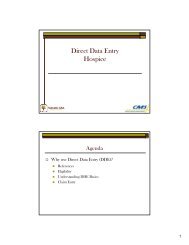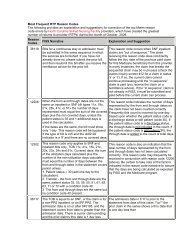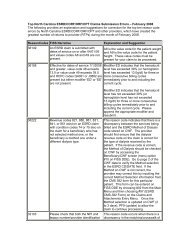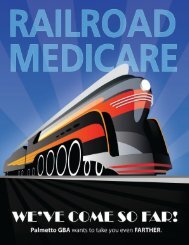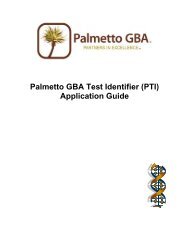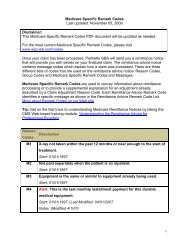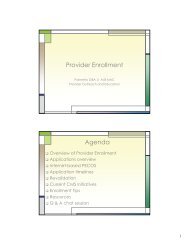PALMETTO GBA 2010 ANNUAL REPORT
PALMETTO GBA 2010 ANNUAL REPORT
PALMETTO GBA 2010 ANNUAL REPORT
You also want an ePaper? Increase the reach of your titles
YUMPU automatically turns print PDFs into web optimized ePapers that Google loves.
NOTES TO FINANCIAL STATEMENTS<br />
36<br />
NOTE 1 BASIS OF PRESENTATION AND SUMMARY OF SIGNIFICANT<br />
ACCOUNTING POLICIES<br />
Palmetto <strong>GBA</strong>, LLC (the Company) is a single-member limited liability company organized on<br />
January 1, 1998. The Company’s sole member is Blue Cross and Blue Shield of South Carolina<br />
(BCBSSC). The Company is engaged in the business of providing Medicare Administrative<br />
Contractor Services, Medicare Part A fiscal intermediary services and Medicare Part B<br />
carrier services in various states. These services include health insurance claims processing<br />
and payment, customer service for Medicare beneficiaries and health care providers, and<br />
payment safeguard functions designed to detect and prevent fraud and abuse in the Medicare<br />
program. The Company provides services to Medicare beneficiaries residing in various<br />
states, Puerto Rico and the U.S. Virgin Islands. The Company’s major customer is the Centers<br />
for Medicare and Medicaid Services (CMS), the federal agency with fiduciary responsibility for<br />
the Medicare program.<br />
In 2009, the Company was notified that it was the successful bidder on the CMS Jurisdiction<br />
11 A/B MAC. This jurisdiction includes the states of North Carolina, South Carolina, Virginia<br />
and West Virginia. Under this five year contract, Palmetto <strong>GBA</strong> would perform all the Medicare<br />
Parts A and B administration for the jurisdiction. The contract also encompasses Regional<br />
Home Health and Hospice Intermediary (RHHI) for 16 states. Although the award of this contract<br />
was protested, the protest was resolved in the Company’s favor in <strong>2010</strong>. This contract<br />
will result in annual revenue of approximately $66,000,000 beginning in 2011.<br />
The financial statements have been prepared in accordance with accounting principles<br />
generally accepted in the United States (GAAP). The preparation of financial statements in<br />
conformity with GAAP requires management to make estimates and assumptions that affect<br />
the reported amounts of assets and liabilities at the date of the financial statements and the<br />
reported amounts of revenues and expenses during the reporting period. Actual results could<br />
differ from those estimates.<br />
Cash equivalents<br />
Cash equivalents represent certificates of deposit that have maturities of less than<br />
three months at date of purchase and money market fund investments. Market risk for<br />
cash and cash equivalents is limited to any one institution when deposits exceed federally<br />
insured limits.<br />
Financial instruments<br />
The Company holds certain financial instruments including cash and accounts receivable.<br />
Management believes that the carrying values of financial instruments approximate fair value<br />
as required by Financial Accounting Standards Board (FASB) rules.<br />
Subsequent events<br />
Subsequent events have been evaluated through February 23, 2011, which is the date the<br />
financial statements were available to be issued. The Company received a capital call from<br />
Health Administration Association of America, LLC (HAAA) in February of an amount up to<br />
$6,000,000. On February 18, 2011, the Company made an initial payment towards this<br />
obligation of $2,000,000.<br />
Asset valuation allowances<br />
The Company recorded an allowance for uncollectible receivables in the amount of $3,000<br />
and $3,000 at December 31, <strong>2010</strong> and 2009, respectively.<br />
Fixed assets<br />
Fixed assets are stated at amortized cost. Depreciation on new assets purchased is computed<br />
using the straight-line method over the estimated useful lives of the respective assets:<br />
four to eight years for furniture and fixtures, three to five years for data processing equipment<br />
and software, and four years for automobiles. Leasehold improvements are depreciated over<br />
the lesser of the remaining lease term or estimated useful life of the asset. Depreciation on<br />
used assets purchased is computed by using the straight-line method over the estimated<br />
remaining useful lives at the time of purchase of the respective assets.<br />
Significant accounting policies and the methods of applying those policies are<br />
summarized below.


